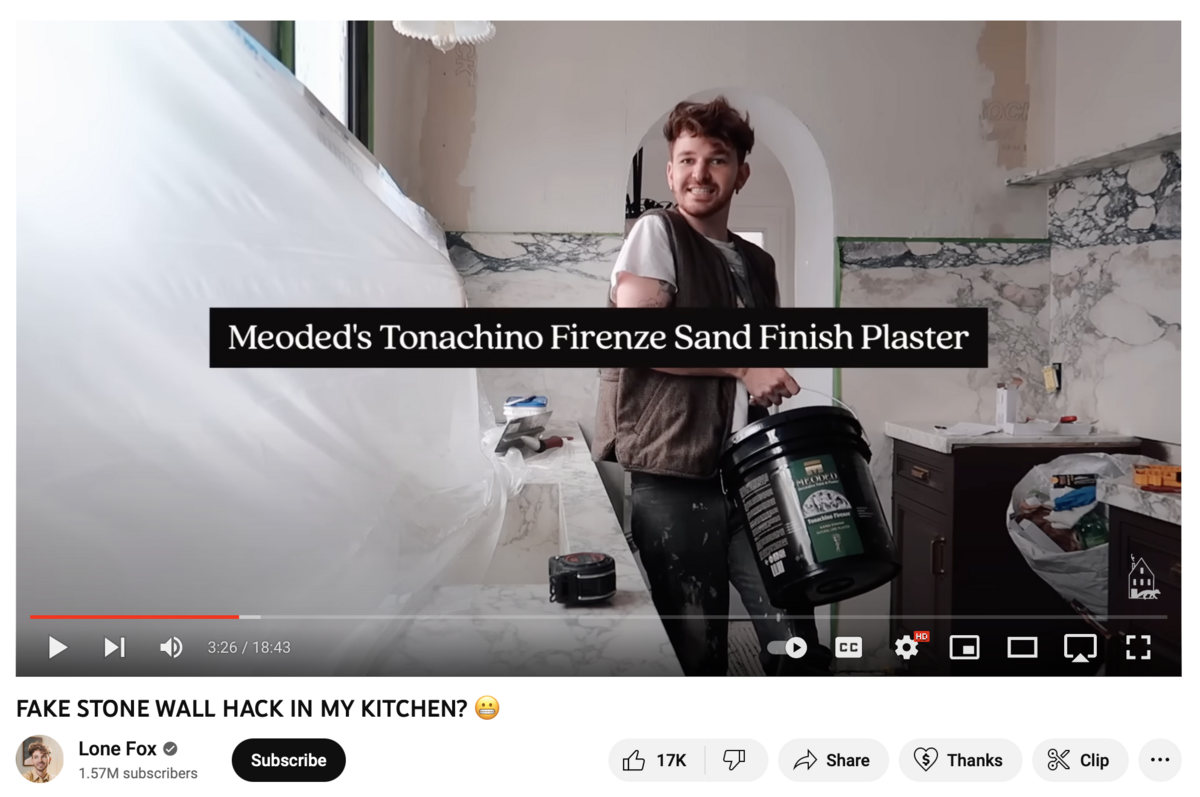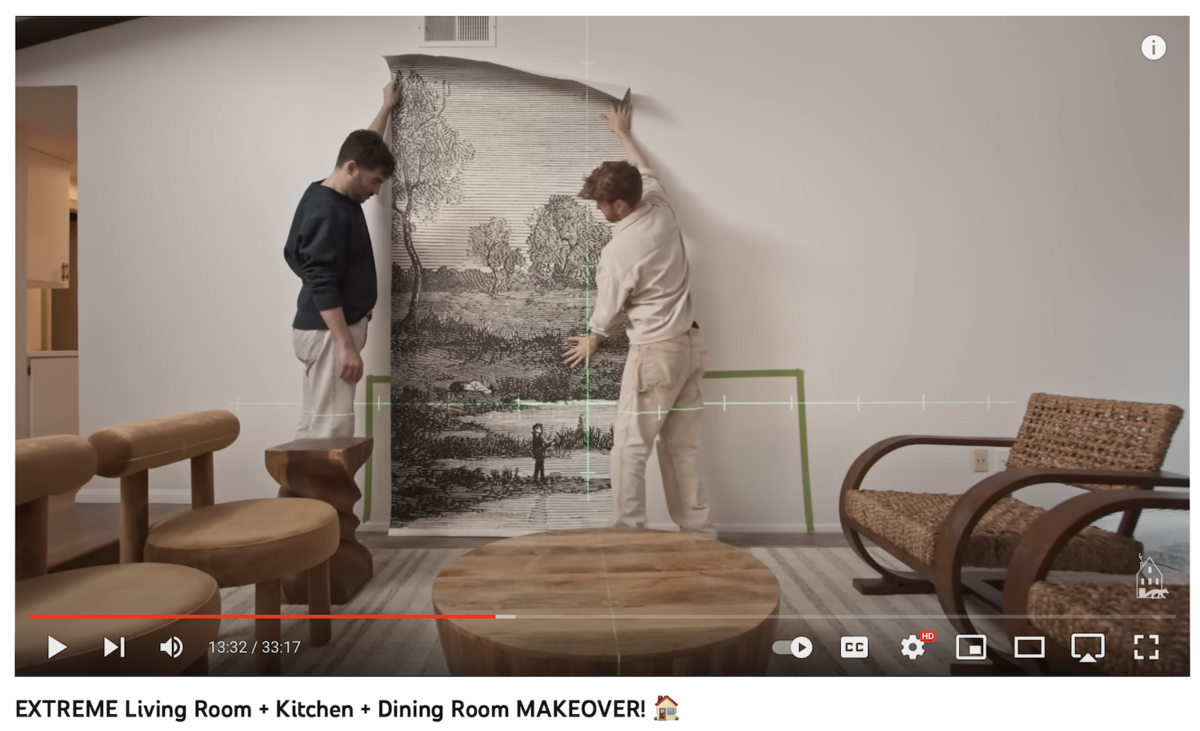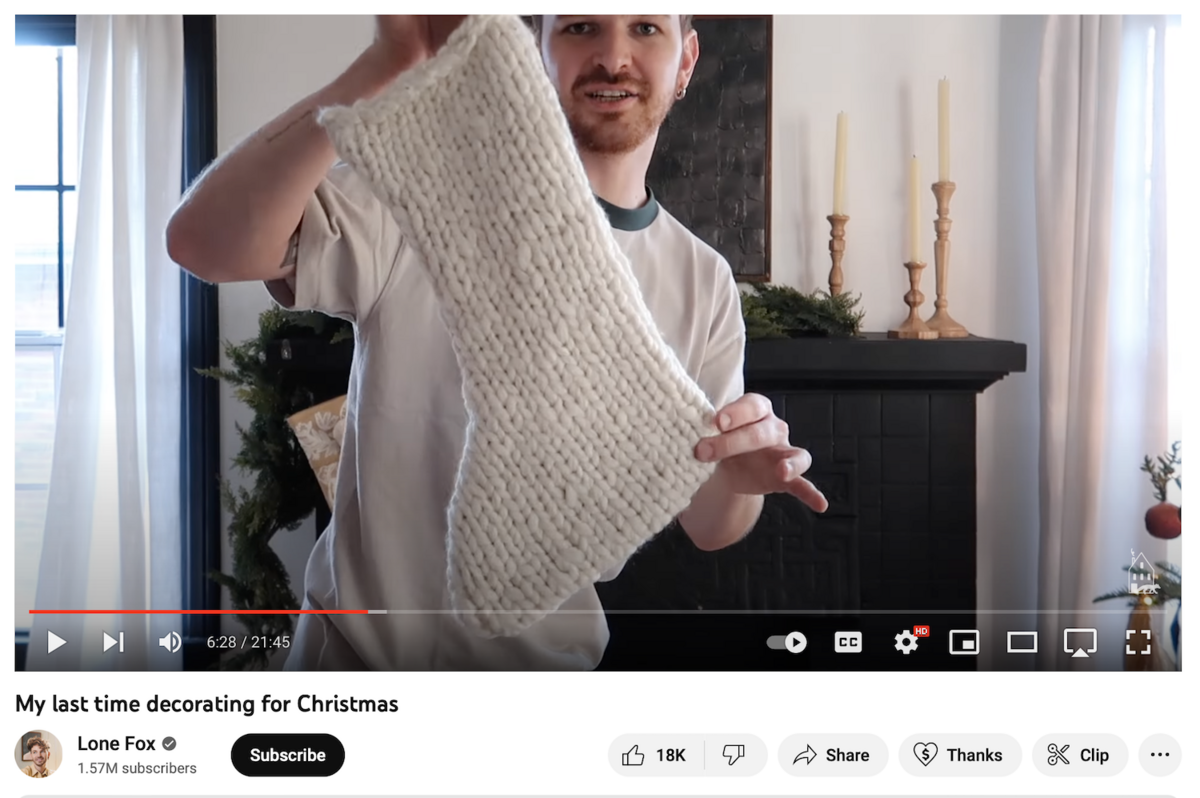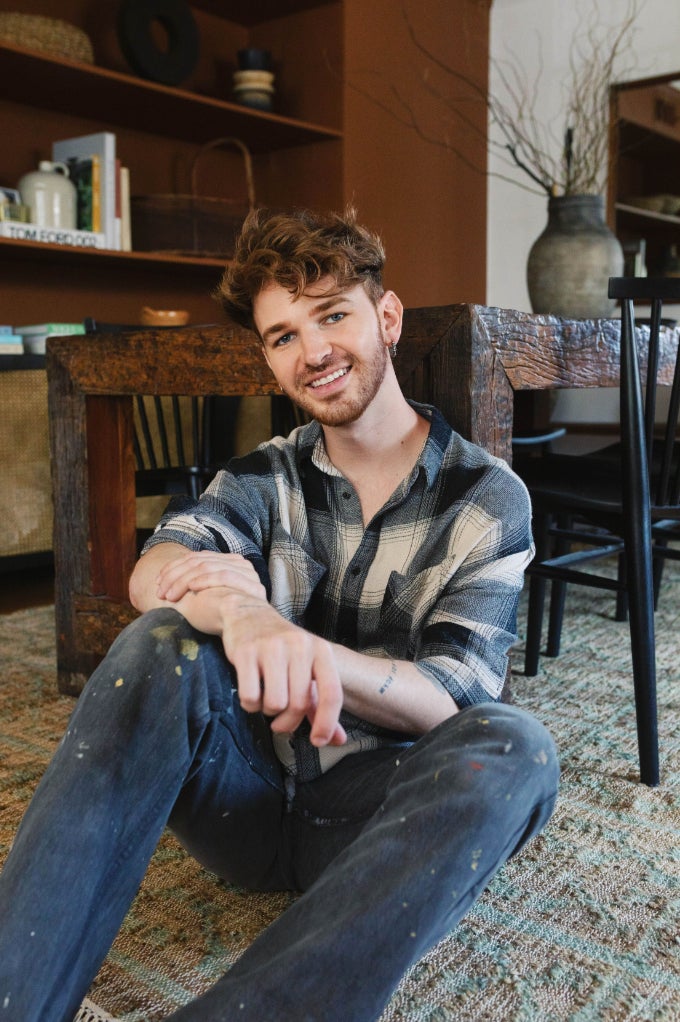In a new series, Ask an Influencer, Business of Home explores the creator economy. This week, we spoke with Drew Scott, the designer and content creator behind the YouTube channel and home business Lone Fox.
Many designers work slow and steady to find success on social media, spending years solving how to approach their business’s online presence. Not so with Drew Scott. At 12 years old, he had already attracted a fast-growing audience on YouTube—and was figuring out how to monetize it. His account centered on scrapbooking (thanks to his big Christmas gift from the year prior, an as-seen-on-TV Cricut cutting machine), and within five years, he’d garnered about 18,000 subscribers and began to attract partnership deals. Not long after, Scott orchestrated his first major brand pivot—timed alongside his transition from high school to the Fashion Institute of Design & Merchandising in Los Angeles—and started a second YouTube channel focused on menswear.
Though his subscriber count continued to climb, 2018 would mark the start of the channel that eclipsed the others and served as Scott’s main focus in the years to come: Lone Fox was where he broadcast an approachable, affordable perspective on home DIY, renovations and decor, quickly amassing a subscriber count that now numbers 1.5 million. He shares how he realized he was undercharging brands for his work, why he doesn’t spend time scrolling on social media, and how he’s refined his approach to engaging with his audience.
You’ve bounced between a few different channels and social media platforms since you began blogging—where is your online presence focused today?
I would say that 80 percent of my life is prioritized around YouTube. I’ve always been extremely into long-form content and videos. TikTok and Instagram are more short-form content, and just not something I’m the most incredible at. I can edit down a short-form piece, but there’s something about a longer video I just enjoy a lot more. Even with my own business, I’m the one that focuses 100 percent on long-form and I’m trying to find someone right now to help with the short-form content.
I really like telling a story with all my videos. I feel like every time I film a content piece, there’s a story I’m wanting to tell or a message I’m wanting to get across, and sometimes it’s hard to do that in short-form content. I can just express myself more and connect more with my audience on YouTube, and I feel like you can build a stronger platform and a stronger community there as opposed to short-form platforms.
Since your online presence has focused on several different subject areas since you first started, has your audience stayed the same or changed over the years?
It has definitely fluctuated. For my scrapbooking channel, the demographic was primarily older women—so it was me, this 14-year-old boy, and grandmas. Then when I did my men’s fashion account, the audience was primarily men. But when I started introducing home videos, and they started getting a lot of views, the viewers were primarily women. That’s when I decided that I wanted to create the Lone Fox channel because the audiences just didn’t intersect—scrapbooking, men’s fashion, and home and DIY—they were completely different audiences. So I was like, “I’m gonna make Lone Fox, and it’s gonna be a brand—I want to build something outside of my own name.” It was just something fun at the time to have a second channel because my fashion channel was actually supporting me fully at that time. Then about a month after creating Lone Fox, I completely stopped the fashion channel.

Is your social media presence a complement to any other business ventures?
Yes—and I’ve always been very entrepreneurial. When I was younger, my first-ever eBay store was selling those strings that you would use in Girl Scouts and Boy Scouts to make little lanyards. You used to only be able to buy them in these 100-yard spools, so I started an eBay store when I was like 11 that allowed people to choose their own colors, and I cut them however they wanted. And it actually got pretty big because you couldn’t buy it elsewhere.
I’ve always had multiple little businesses. The [Lone Fox e-commerce store] launched a little over three years ago and started as primarily a website for merch—I just had some sweatshirts and tote bags and things—and then about two years ago it developed into home decor. It actually supports my parents and my aunt as well, so it’s kind of like a family business.
When did you start approaching social media with a strategy?
When I started the Lone Fox channel, I decided to take this really seriously because at that point, I had my fashion channel and I was just making enough to pay my rent and my monthly bills. I was making enough to get by, but I realized there was more I could make, and I also felt like at that point I was kind of plateauing with men’s fashion. I saw something bigger with Lone Fox than I did with men’s fashion. That’s when I decided to build an actual strategy around Lone Fox, and I didn’t want to be the face. That’s kind of why I called it Lone Fox. What I really wanted was to have a brand that wasn’t like Drew Scott Design or something pertaining to me. I wanted to build something different—an aesthetic, a vibe and a whole community around Lone Fox, which I’ve been absolutely loving doing over the past three years.
What does your content schedule look like?
I am someone that [operates] on a whim—if I film a piece of content and it’s a week old, I’m already bored of it and I’m on to the next thing. I’ve always worked like this: If I’m filming, editing and uploading, it’s happening on the same day. For Lone Fox, I do spend multiple days building for one video, but I have to get the content edited and turned around really fast for me to want to still post it. So I don’t have the most strict schedule when it comes to content, and I’m the only one behind Lone Fox that does all of the content, so I can post freely and I make sure I try to post one to two videos a week. And then whatever I can post in addition on short-form platforms, I post that as well.
Trends change so fast that it’s really hard—say, you have a rough schedule of posting one TikTok and one YouTube video a week, but the content and the topic itself, for me, still needs to be fresh every week. I need to post right away, or it doesn’t feel like it can go as viral as that week that I was thinking of it, if that makes sense.

What does the process of producing content look like for you?
I don’t do anything too crazy because I really like my content to feel attainable. I like to create content that feels like other people can also create. So I don’t really use too much insane equipment—really, just a vlog camera, which is a little point-and-shoot camera. But I do also have a DSLR camera that I use for all my photos, and I will use it for higher-quality video clips if I need them here and there.
I actually hate editing on my phone—I’m really bad at it, probably because I’ve been editing on my computer for like 12 years. Since I’m really speedy with the computer, I edit everything on Final Cut Pro. Other than that, a favorite app of mine is Tezza, which is like a coloring and filtering app. I put a Tezza filter on almost every single piece of content that I create. That way, I don’t really have to worry about the color because the filter always enhances it.
How did you start working with brands?
My older [men’s fashion] channel was the first one where I started talking [with potential brand partners], and I was like, “OK, this is actually something that people can make money from.” But I did it for years and years and years before even realizing you can make a dollar—creating videos was really just a love and a passion of mine. But as my fashion channels got bigger, I saw a little bit of income coming in because men’s fashion and grooming brands started reaching out to me. That’s when I started realizing that brands actually were working with influencers, and it was kind of like a new thing for everyone. A lot of influencers didn’t really know how much you’re supposed to charge and how contracts work and if you’re supposed to have management—it was brand-new to everybody, and it was really interesting at the time.
How do those brand relationships usually begin?
I’ve actually never pitched a brand before other than if, for example, I want to get a tile for my kitchen—recently, I reached out to brands for kitchen tile because I realized their tile was so expensive. So I was like, “Let’s do another project.” Normally, brands inquire with me via email because I have always had my email on my platform, whether under a YouTube video or on Instagram or TikTok. Over the years, it’s definitely picked up. I feel like as you build your name and people move around within PR companies and introduce new contacts here and there, it helps create opportunities.
How do you decide what your rates are for those partnerships?
When I first started out, I did my own rates for years before ever getting to talk to management. I had no idea what to do. I would just blindly email brands and ask for a figure, and every time I would do that, it would be so nerve-wracking because I would be like, “Oh, my gosh, I just asked for this money, and they’re not even gonna respond—and this is my opportunity to pay my rent this month.” I would be so nervous that I would lowball myself because I just wanted to secure that offer.
How did you realize you were undercharging?
When I started working with a management company, I realized you can actually make quite a bit more. I was doing my own deals for so long, and then I started seeing those deals increase—and even though I was paying out 20 percent to a management company, I felt like they were bringing in a lot more money in the first place. It also felt like there was a lot more security behind what I was doing, because I had this management backing and it wasn’t only me talking to the brands. Before, if there was ever an issue, [the brands] were just emailing directly with me.
Do you refer to yourself as a content creator, an influencer, a designer?
I never really considered myself an interior designer when I first started. I would get asked, “How do you want to be referenced in the portfolio pieces?” I always felt like I was a content creator because that’s what I already was—I would wake up and film videos and edit. Even though home was the topic of the content I was creating, it wasn’t until I really started designing spaces that I felt like I could call myself an interior designer.
I think for a while I knew there were certifications and such that you needed to be called an interior designer, so I didn’t want to undermine actual interior designers. Also, I felt like real interior designers probably don’t love content creators because they’re sharing with people how they can create these spaces for so much less.

Do you use social media for personal reasons anymore?
I don’t. I’m really not a content scroller, and I’m not someone that really consumes social media, which is so strange. It’s my job, and I’ve done it for so long that I kind of just post and get off the platform, which sounds crazy. I do go on TikTok at night when I’m bored, but I’m not someone that’s scrolling on Instagram. I just naturally take in things that I like as inspiration, and then I put it into my content and put that out. And then I’m on to the next thing.
I feel like sometimes you can get caught up a little bit in trends as well. Like, if you go on social media, and you see everything people posted at the time—the trends are great, but following them to an extreme can sometimes not be the best. I try to be more at the forefront of trends, of course.
I also really prefer video content, so you’ll find me watching YouTube videos—but it’s actually very hard to find home-focused YouTube accounts. It’s hard to find that content, believe it or not, whereas you can find a ton of people that do home-based content on short-form platforms—I think because it’s a lot more attainable to just pull out your phone and shoot the content, whereas on YouTube you have to have a little bit more of a strategy, maybe even a background in video editing.
Interior design is a much harder type of content to film. It takes a lot of time to film an entire room makeover. At the start of long-form content [like YouTube], people weren’t wanting to do an entire makeover or grand reveals. So it started off feeling a bit daunting to create long-form home content. Whereas with short-form content, people instantly digest and enjoy attainable little tips and hacks.
How do you field comments and DMs?
I go through my DMs and I’ll respond every now and then, but I can’t open every DM and respond to every message even though I’d love to. But I love creating little forums for comments, and I love coming back to my subscribers on YouTube. I think it goes back to the fact that I’ve [interacted with that community] for like 12 years, and that’s something I’ve always loved doing. So if I see a bunch of questions coming in about something, I’ll try to answer them.
Did your life change when you started to build a following?
More so recently, when I’m going to antiques markets and flea markets and vintage stores, where I see a lot of my subscribers or followers. I’ve always felt kind of exactly the same, but when I first started creating content I was younger—I was still in high school when I started my scrapbooking channel. So a 14-year-old boy having a scrapbooking YouTube channel in their high school wasn’t something you wanted everyone to know about.
How are you thinking about using other platforms?
That’s always challenging for me. When I first started posting on TikTok, there was almost no one posting about home, so I felt like I was blindly posting for about a year and getting zero engagement. I was like, “This platform is not for home content; no one’s liking home content on here.” But also, short-form content was brand-new to me—I saw people doing TikTok dances and, like, quick-stop edits and cuts and things, so I was trying to interpret those into home content by doing quick fast-cuts on DIY projects. But it wasn’t really digestible. I had to find ways to mix the cool, engaging short-form content aspect while still giving viewers the benefit of the project and why you’re actually watching the video. It took me a while to figure out that recipe for my content.
What are you working on right now, from a process or business-strategy perspective?
I’m honestly just excited to continue growing with the community that I’ve created. Within the past six months since buying [my new] house, I feel like I’ve created an even stronger community on my channel. People really love tuning in every Thursday and Sunday for the videos or a post of making over the house, and it’s just so rewarding—waking up and posting it. I feel like everyone’s looking forward to it. And I just love being able to work on my own house and to do something that I really love, and being able to share with people and to give them inspiration and tips for their own home.
Homepage image: Drew Scott | Courtesy of Ethan Gaskill





























